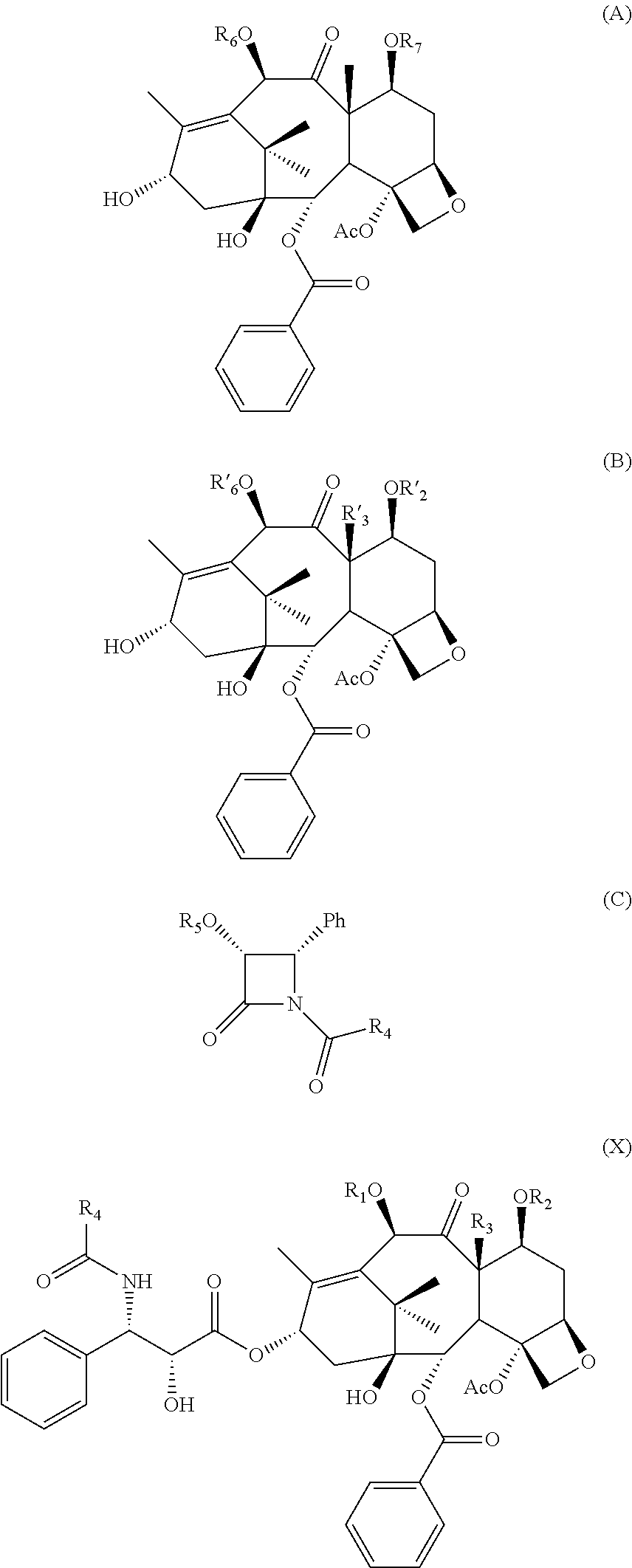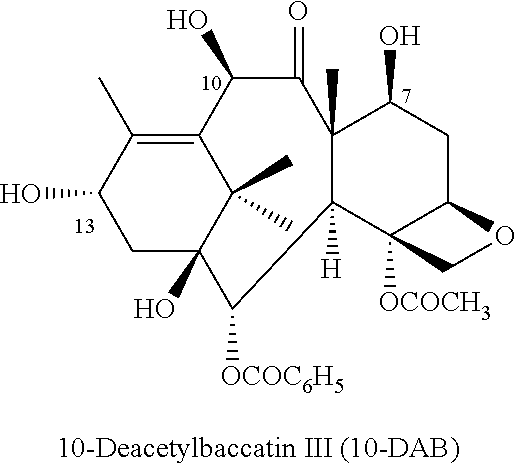Process for preparing taxoids from baccatin derivatives using lewis acid catalyst
a technology of lewis acid catalyst and baccatin, which is applied in the field of process of preparing taxoids from baccatin derivatives, can solve the problems of expensive extraction and purification of taxol from yew
- Summary
- Abstract
- Description
- Claims
- Application Information
AI Technical Summary
Benefits of technology
Problems solved by technology
Method used
Image
Examples
example 1
[0107]
Preparation of 7,10-di-triethylsilyl-10-deacetylbaccatin (III) (D2) Catalyzed by LiBr
[0108]To a solution of 10-DAB (10 g) and DMAP (1 eq, 2.2 g) in 200 mL of THF at 25° C. under nitrogen was added triethylamine (18 eq, 45.8 mL) and TESCl (8 eq, 25 mL) dropwise and was kept stirred for 3 to 4 hours. After the consumption of 10-DAB, LiBr (1 eq, 1.6 g) in 10 mL THF was added to the reaction mixture. The reaction was stirred at 65˜70° C. for 3˜5 hours and then stirred at 20˜30° C. for following 13˜16 hours until the reaction is completed. The reaction solution was diluted with 200 mL ethylacetate and washed with 200 mL water. After partition, the organic layer was dried by rotavapor. The crude D2 obtained after evaporation was digested with 120 mL n-hexane for 3˜4 hour. Finally, the product (yield 89%, 12.6 g, LC purity 98%), 7,10-di-triethylsilyl-10-deacetylbaccatin (III), dried under vacuum after filtration was obtained. 1H NMR (CDCl3, 400 MHz) δ 8.10 (d, J=7.6 Hz, 2H), 7.58 (t,...
example 2
[0109]
Preparation of 7,10-di-triethylsilyl-10-deacetylbaccatin (III) (D2) Catalyzed by MgBr2
[0110]To a solution of 7-triethylsilyl-10-deacetylbaccatin (III) (D1, 1 eq) and MgBr2 (0.5 eq) in THF after stirred for 30 minutes at 25° C. under nitrogen was added DMAP (0.5 eq), triethylamine (8 eq) and TESCl (4 eq) dropwise. The reaction was stirred under reflux for 46.5 hours. The reaction solution was diluted with ethylacetate and washed with water. After partition, the organic layer was dried by rotavapor to obtain the crude D2 (LC purity 48%).
example 3
[0111]
Preparation of 7,10-di-triethylsilyl-10-deacetylbaccatin (III) (D2) Catalyzed by a Mixture of CsBr and LiBr
[0112]To a solution of 7-triethylsilyl-10-deacetylbaccatin (III) (D1, 1 eq), CsBr (0.5 eq) and LiBr (0.5 eq) in THF after stir for 30 minutes at 25° C. under nitrogen was added DMAP (0.5 eq), triethylamine (8 eq) and TESCl (4 eq) dropwise. The reaction was stirred under reflux for 46.5 hours. The reaction solution was diluted with ethylacetate and washed with water. After partition, the organic layer was dried by rotavapor to obtain the crude D2 (LC purity 78%).
PUM
| Property | Measurement | Unit |
|---|---|---|
| temperature | aaaaa | aaaaa |
| reaction temperature | aaaaa | aaaaa |
| temperature | aaaaa | aaaaa |
Abstract
Description
Claims
Application Information
 Login to View More
Login to View More - R&D
- Intellectual Property
- Life Sciences
- Materials
- Tech Scout
- Unparalleled Data Quality
- Higher Quality Content
- 60% Fewer Hallucinations
Browse by: Latest US Patents, China's latest patents, Technical Efficacy Thesaurus, Application Domain, Technology Topic, Popular Technical Reports.
© 2025 PatSnap. All rights reserved.Legal|Privacy policy|Modern Slavery Act Transparency Statement|Sitemap|About US| Contact US: help@patsnap.com



